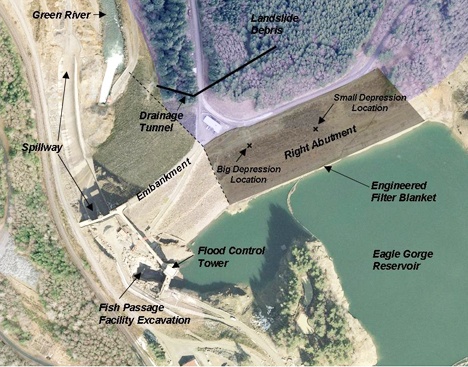U.S. Army Corps of Engineers representatives met with contractors concerning the grout wall on the Howard Hanson Dam on Tuesday.
The grout wall, a seepage barrier, is intended to address concerns prompted by two depressions that opened on the dam’s right abutment or natural support in the January floods. It will be 450 feet long across the face of the abutment and vary in depth between 90 and 160 feet.
Col. Anthony Wright, commander of the Seattle District of the Corps of Engineers, told local leaders Monday in Seattle that the grout wall will be completed by Nov. 1.
“There is no plan to raise the reservoir at all after Nov. 1, except to conduct flood operations,” said Seattle District Corps Spokeswoman Casondra Brewster. “During the fall-winter rainy season, we keep the reservoir behind the dam virtually empty, near the ‘mud pool’ level of 1070 feet above sea level.”
Site work will begin next week.
The grout wall is only an interim fix. The as-yet-unknown, permanent solution to the dam’s woes could be five years off and cost hundreds of millions of dollars, Wright said.
That means residents in downstream communities like Auburn will have to live with the possibility of flooding of the Green River until a permanent solution is found and implemented.
“If we have a big enough storm, we will release water from the reservoir that will exceed the capacity of that levee system,” Wright said.
The Corps will not test again until next spring.
Nothing said at the Monday briefing did anything to allay the concerns of local leaders fretting the very real possibility of flooding for the first time since the dam was completed in 1962. At that time, Auburn’s population was less than 17,000. Today it is more than 68,000.
“Over the last 20 years, at least one third of the time water has gone well above the 1,155 mark,” said Auburn Mayor Pete Lewis. “Any water above that line is coming down the river. Six out of the last 20 years, it went above the level that we could handle for a number of days, which is 12,000-cubic feet-per-second at the Auburn gauge.”
Any permanent solution would almost certainly involve extending the dam itself, said Mamie Brouwer, program manager for the Howard Hansen Dam.
“Using the usual process, studies can take up to three years to complete,” Brouwer said. “We are looking to accelerate things so that we can start in the fiscal year 2011. We just don’t know what the permanent fix would look like. We’re not just talking about the right abutment, we are looking at all aspects of the dam. In terms of the dam safety modification study, we don’t know what other issues might arise.”
In the interim, city officials are worried about flood waters topping the levees. The Corps, King County and the City of Kent started work Monday on the Horseshoe Bend sections of the Green River levee in Kent. This summer the Corps and King County will effect minor repairs to the Galli levee north of Isaac Evans Park.
“Some of the slope unraveled last January and was lost,” Lester Soule, Corps project manager for levee rehabilitation work, said of the Galli levee. “We’re going to go out there and update what we did downstream of that bridge last year.”
Of major concern to Auburn officials is the Reddington levee north of Brannan Park.
“If Reddington goes, the River Mobile Home park is underwater immediately,” Lewis said. “One half-hour later, King County conservation land is under water, and that’s a gun aimed right at Kent,” Lewis said.
Work on the Reddington levee is not scheduled until next summer.
“We’ve done a pre-inspection with King County, and there doesn’t appear to be any major erosion or scouring along the Green River Road face. But with the flows being lower right now, we will look at the toe of the levee to see if it is scoured away,” Soule said.
The cities of Auburn, Kent, Tukwila and Renton are considering an emergency declaration to get assistance from the state to expedite work on some of the more worrisome levees.
Lewis said residents need to be prepared.
“People need to get flood insurance, now,” Lewis said.



